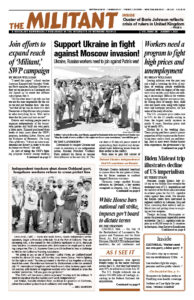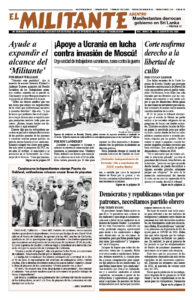Thousands of protesters occupying the residence of Sri Lankan President Gotabaya Rajapaksa and the office of Prime Minister Ranil Wickremesinghe handed the buildings back to the government July 14 after Rajapaksa fled to Singapore and resigned.
The occupation of the luxurious residence exposed the class divisions in Sri Lanka, where millions are skipping meals because of the deep economic and social crisis, while the ruling rich and capitalist politicians live in extravagance.
On July 20, Parliament — dominated by Rajapaksa’s party — voted to elect Wickremesinghe president.
The middle-class-led protest movement, which has kept up a camp since April 9 near the presidential palace, had opposed the selection of Wickremesinghe, instead calling for an “interim government” to initiate steps toward new elections.
After Wickremesinghe’s election, the Inter University Students Federation said it would continue its campaign to “chase away the Ranil-Rajapaksa junta.”
But a change of faces from one bourgeois faction to another will do nothing to offer a road forward against the capitalist government that has put the crisis on the backs of working people for years.
A combination of the worldwide decline in trade and production, exacerbated by the COVID-19 pandemic and Moscow’s invasion of Ukraine, along with the disastrous decision last year by Rajapaksa to ban the import of synthetic fertilizers and pesticides and impose 100% organic farming on the country’s farmers — reversed after protests — has brought the country to bankruptcy.
The regime in Beijing bears a special responsibility for the crisis facing working people in Sri Lanka. China’s rulers saddled the country with “Belt and Road” projects that helped bankrupt it. Beijing now controls the Sri Lankan port of Hambanthota.
With less than $25 million in cash on hand, the government has stopped making payments on its $51 billion foreign debt, $6.5 billion of it owed to Beijing. The government restricted the sale of fuel. Drivers now wait on mile-long lines for days at a time to get a few gallons of gas, while the price of food has skyrocketed.
The course of Rajapaksa’s government was pointed to by bourgeois opposition parties to promote the illusion that the problem in Sri Lanka is corruption tied to one family or party. But this is just one piece of the capitalist exploitation and imperialist plunder of the natural resources and labor of the people of the country.
Capitalist lenders from the World Bank to the International Monetary Fund, from Beijing to New Delhi and beyond, are jockeying to get their hands on loan repayments and to profit by sinking Sri Lanka further into debt.

